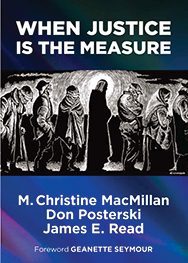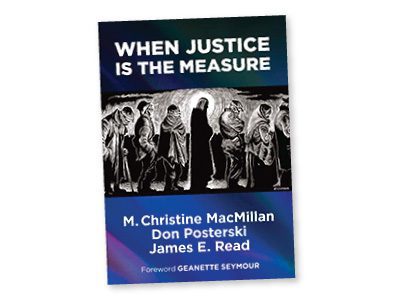By Kevin Jackson, Major –
 The Salvation Army is historically linked to its efforts for social justice. Yet, written works on the topic from a Salvation Army perspective are somewhat of a rarity. This is but one reason why “When Justice is the Measure” (The Salvation Army Canada and Bermuda Territory, 2014) by M. Christine MacMillian, Don Posterski, James E. Read is a welcome and needed addition.
The Salvation Army is historically linked to its efforts for social justice. Yet, written works on the topic from a Salvation Army perspective are somewhat of a rarity. This is but one reason why “When Justice is the Measure” (The Salvation Army Canada and Bermuda Territory, 2014) by M. Christine MacMillian, Don Posterski, James E. Read is a welcome and needed addition.
I have come to appreciate the combination of an economy of words and powerful, well-written prose as this work does. Attempting to interpret the words of the Bible and the life and ministry of Jesus with justice as the measure could be a daunting task, but the authors crafted a meaningful challenge for all to step up and work toward a day when social justice reigns in our world. The book is a combination of thoughtful chapters on inclusion of the outsiders, challenging cultural practices such as racism, confronting the powerful and advocating for the poor.
Included in each chapter are opportunities for the reader to identify social justice issues within their individual societies and then written prayers in response to each of the issues, which the author and reader identify. The reader is also encouraged to write their own specific prayers.
Each chapter teases out social justice issues in a general theological sense. As a Salvationist, I was thrilled that the authors chose to add a section to each chapter of the book titled “The Salvation Army Story.” It directly applies short historical narratives demonstrating our tradition of addressing social justice issues around the world and topically as they were presented in each chapter.
In his recommendations for this book, General André Cox referred to the book as “refreshing.” I concur. Combining Biblical, theological, social commentary and historical narrative is a complex task. Yet the authors managed to synthesize the complexities of social justice into a readable resource. Further, all too often books regarding social justice identify issues in the world, but offer precious little praxis. The authors succeeded on both accounts in a mere 120 pages.
I wholly recommend “When Justice is the Measure.” It is profitable for both the individual and for use within a small group. We now have in our hands a well-written resource to assist us in accomplishing the tremendous challenges we face in the world. We can utilize this work on the local level to know what justice really does look like in our world.











